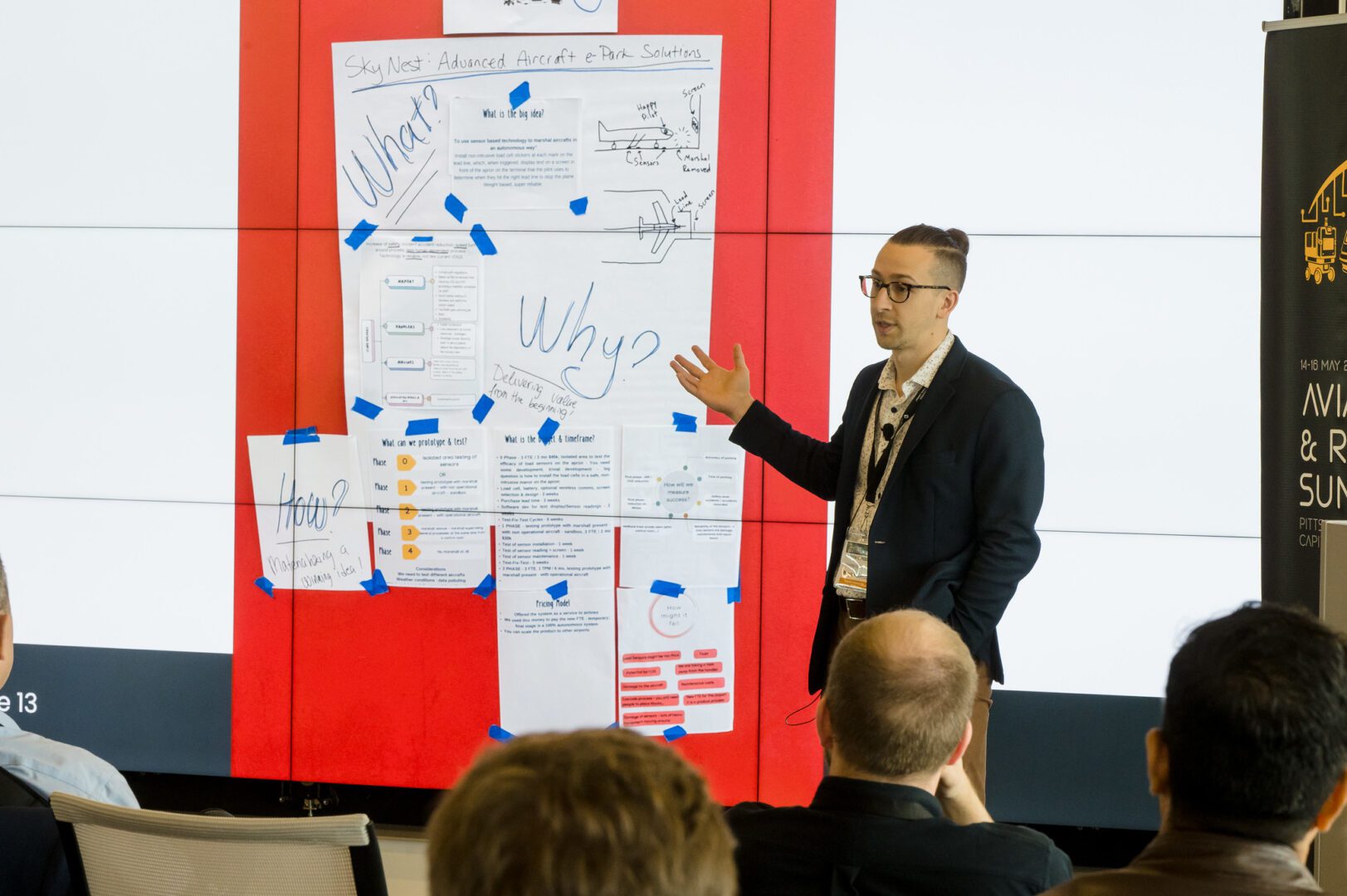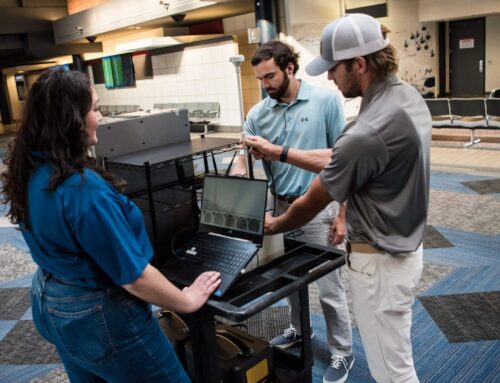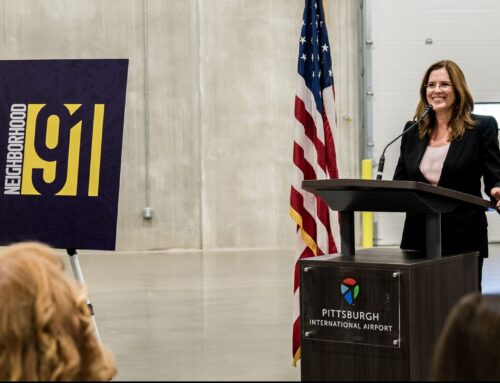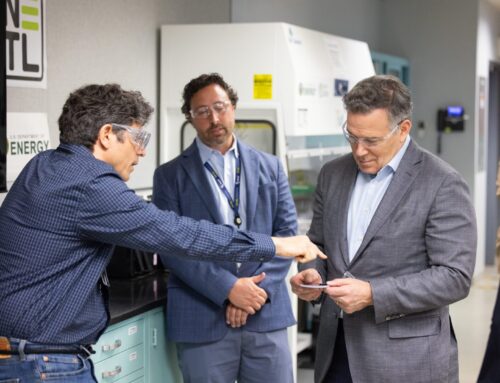Aviation & Robotics Summit Ideas Pave the Way for Next Generation of Travelers
Three-day event gives aviation, robotics and tech professionals a platform to change air travel, improve customer experience
By Gina Mastrangelo
Published May 24, 2024
Read Time: 4 mins

Aviation is the result of innovation.
Since its birth, the industry hasn’t stopped progressing. And as robotics and artificial intelligence continue to thrive, aviation will too.
Using technology to make travel easier was a focus of myriad conversations among roboticists, technologists and airport and airline professionals during Pittsburgh International Airport and Future Travel Experience’s Aviation & Robotics Summit.
The event brought together global aviation, robotics and tech industries to Pittsburgh to solve industry challenges.
“There is a whole group of really smart people running robotics at AI and automation companies who have never really even considered aviation as an industry to go into,” said PIT CEO Christina Cassotis. “And aviation wasn’t necessarily looking at the robotics companies to solve solutions, so we put folks together and all of a sudden, on our own campus, we’re seeing solutions to problems we didn’t even know could be solved in these ways.”
The future of air travel
The event culminated with robotics, tech and aviation professionals coming together to invent ideas that could make travel easier.
One workshop group suggested using LiDAR sensors to send foreign object debris (FOD) locations to ramp workers, quickening the process for its removal. Another group developed a process that uses sensors to quickly turn planes between flights. Meanwhile, a team worked together to present technology that increases accuracy for baggage handlers.
At the summit kickoff, Cassotis announced that PIT will select a prototype from the workshops to go to market, backed by $75,000 in funding, thanks to the Henry L. Hillman Foundation, and that prototype could be selected from the ideas groups presented at the workshops.
This year, the summit drew more than 100 participants from around the world, all sharing the same goal: to develop solutions to some of the industry’s most pressing challenges.
“It’s incredibly important to bring everyone here, all to one town, all into one venue,” said Bernadette Berger, director of innovation at Alaska Airlines and kickoff event keynote speaker. “We have a whole table with an engineer, an airline executive, an airport executive, all discussing the same challenge but from different perspectives.”

(Left) Siri Betts-Sonstegard, SVP of Experience & Design at PIT, leads a discussion on implementing robotics and technology solutions in the industry. (Photo by Joe Appel/Blue Sky News)
Airports, airlines introduce groundbreaking tech
Throughout the summit, aviation leaders spoke of the future tech that could change the way we see air travel.
At the kickoff event, Berger emphasized Alaska Airlines’ goal to examine not only air travel as it exists now but to define solutions that cater to the next generation of travelers.
“Airlines and airports are built to run effective, efficient and safe operations day to day, and that is incredibly important,” she said. “It’s also important to have an innovation practice that can run parallel so that you give teams the time to think ahead, to think multiple quarters, multiple years out and predict what are the challenges.”
Kristen Berndt, senior manager of Baggage Strategy & Innovation at United Airlines, is part of a team with a focus on robotics and innovation. United is growing rapidly, and more passengers means larger volumes of baggage. So, Berndt and her team are developing robotics solutions to ensure the travel experience stays seamless.
Meanwhile, Keenan Hamza, VP of technology futures & innovation at Emirates Group, mentioned Dubai’s new airport, which will have five parallel runways and five terminals, making it one of the largest in the world. This project opens up an opportunity to introduce more robotics into airport operations.
With so many creative and innovative minds in one room, brainstorming new ideas seems to come naturally, but putting them into practice presents a new world of challenges. Siri Betts-Sonstegard, SVP of Experience and Design at PIT, moderated a panel to discuss just that.
“There’s so many reasons why things should work and there’ll be some reasons why people will say why you can’t do something,” said Tom Cannell, SVP Airports Future at IAG Airports and one of the panel speakers.
“You make things happen. You have an open door to new ideas and ways of working and building on other people’s ideas, because it might be that you stick to ideas past, but it’s about building on others and creating something that can make noise and excite people and get to where we need to get to.”
Furthering innovation at PIT
PIT is driving innovation through its xBridge program, a partner that tests new technology from local startup companies on the airport campus. During the summit, attendees got to see xBridge in action.
Mapless AI was just one of many projects on display. The organization, which has been testing at PIT since 2022, develops tech that allows vehicles to drive with teleoperated communications. The vehicle can drive itself to a specific location in the city, where the traveler can then take over and drive themselves to the airport, all while a staff member sits in an office miles away and controls the vehicle.
“Airport use case is interesting to us, especially because a lot of people go to and from the airport and the city back and forth,” said Jeff Johnson, co-founder of Mapless AI. “It’s hopefully an easier and more convenient solution than say, taking a Lyft or taxi.”
As PIT welcomes more xBridge projects, it moves closer to opening its new terminal, designed and built for the modern Pittsburgh traveler. And, thanks to events like the Aviation & Robotics Summit, the airport has a platform to bring these innovative ideas to the rest of the industry.
“These are the true trailblazers that will light a path for the rest of our industry to follow,” said Daniel Coleman, founder and CEO of FTE, to the room of summit attendees at the kickoff event. “And I’m very proud that we’ve been able to gather you all here to inspire your next steps in the use of AI and robotics, which I’m sure will become as ubiquitous to our sector as electricity or connectivity.”






